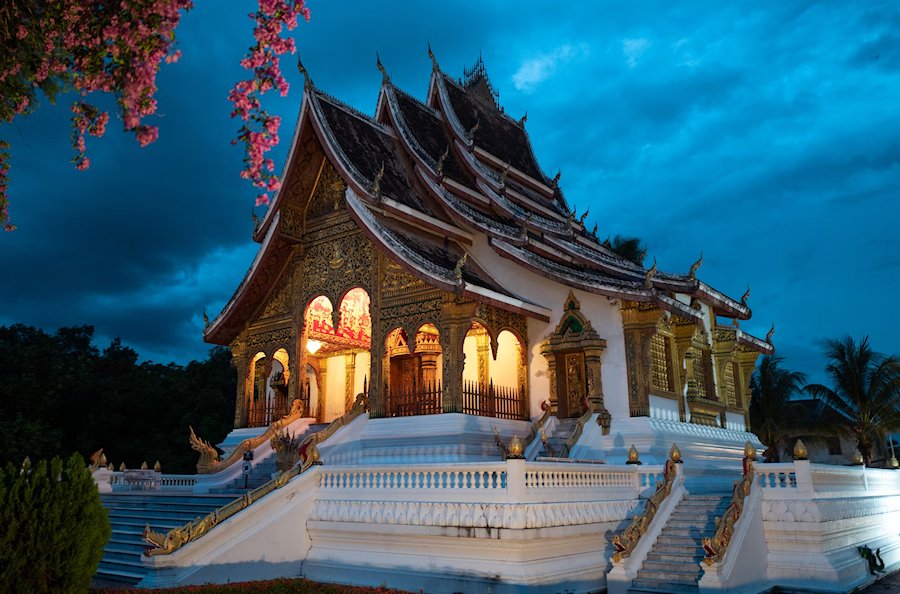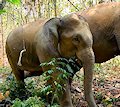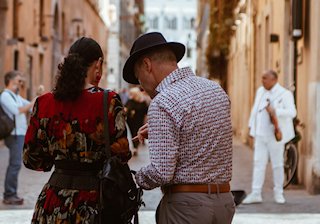Travel Notes: Destinations: Asia: Laos - Luang Prabang Travel Guide.
Short URL: https://tnot.es/LPG
Travel Guide For Visitors to Luang Prabang
Ancient temples, French colonial charm, and the Mekong River converge in Luang Prabang; UNESCO World Heritage city considered the crown jewel of Laos. Share on Facebook
Picture This
Imagine sipping Lao coffee as saffron-robed monks pad silently past your café table, their morning alms ritual unchanged for centuries.
 Add a Business -
Add a Location -
Add a Lodging - Add Travel Content
- Add URL
- Travel Services.
Add a Business -
Add a Location -
Add a Lodging - Add Travel Content
- Add URL
- Travel Services.
This is Luang Prabang
Welcome to a place where time moves at the pace of the Mekong River and every street corner tells a story spanning kingdoms, colonial empires, and spiritual devotion.
Perched at the confluence of the Mekong and Nam Khan rivers in northern Laos, Luang Prabang strikes that rare balance between preservation and progress.
The entire historic centre earned UNESCO World Heritage status in 1995, protecting over 30 Buddhist temples alongside French colonial architecture that wouldn't look out of place in Provence.
Why Visit Luang Prabang
A Living Museum of Southeast Asian Culture
Unlike many heritage sites that feel frozen in time, Luang Prabang pulses with authentic daily life.
Local families still inhabit traditional wooden houses, vendors hawk fresh produce from bamboo baskets, and Buddhist ceremonies continue as they have for generations.
You're not observing culture through a window glass; you're walking through it.
French Colonial Architecture Meets Lao Craftsmanship
The French Protectorate period (1893-1954) left an architectural legacy that complements rather than competes with traditional Lao buildings.
Croissants and café au lait sit comfortably alongside sticky rice and laap, creating a unique cultural fusion you'll find nowhere else in South-east Asia.
Unmissable Spiritual Experiences
The daily alms ceremony remains one of South-east Asia's most profound spiritual experiences.
Every dawn, hundreds of monks collect rice and other offerings from locals and visitors alike.
This isn't a tourist show; it's a sacred tradition that connects you to the Buddhist faith that shapes Lao society.
Top Attractions in Luang Prabang
Kuang Si Falls
Located 29 kilometres south of the city, these multi-tiered limestone falls create a series of turquoise pools perfect for swimming.
The main cascade drops 60 metres through tropical forest, whilst smaller pools offer natural jacuzzis at comfortable temperatures year-round.
A rescued bear sanctuary operates near the entrance, caring for Asiatic black bears saved from the illegal bile trade.
Getting There
Tuk-tuk (1.5 hours), motorbike rental, or organised tour.
There is a small admission fee and swimming is only allowed in designated pools.
Mount Phousi
This 100-metre hill sits smack in the centre of town, offering panoramic views across the UNESCO zone and surrounding rivers.
Local legend claims Buddha's footprint is embedded in the rock at the peak.
The climb up 328 steps takes around twenty to thitry minutes and rewards you with Wat Chom Si temple at the summit; and arguably the finest sunset views in Laos.
Try to arrive forty-five minutes before sunset to secure a good viewing spot.
Royal Palace Museum
The former residence of the last Lao king, Sisavang Vong, now houses an impressive collection of royal regalia, religious artifacts, and gifts from foreign dignitaries.
The Throne Hall gleams with gold leaf and precious stones, whilst the museum's prized possession, the solid gold standing Buddha called Pra Bang, gives the city its name.
Wat Xiengthong
The jewel of Luang Prabang's temple crown, Wat Xiengthong showcases the finest examples of classical Lao architecture.
Built in 1560, its sweeping rooflines cascade towards the ground like a waterfall frozen in gold and crimson.
The sim (ordination hall) houses intricate mosaics depicting Buddhist stories, whilst the Red Chapel contains a rare reclining Buddha statue.
Try and visit early morning or late afternoon for the best light.
Where to Stay in Luang Prabang
Budget-Friendly Choices
Modern hostel facilities including air conditioning, hot showers, and reliable Wi-Fi.
The social atmosphere attracts backpackers from around the world.
Thongbay Guesthouse (Ban Viengmay Vat Sakem).
Family-run accommodation offering clean rooms and genuine Lao hospitality.
The rooftop terrace provides mountain views, whilst the ground-floor restaurant serves affordable local dishes.
Luxury Accommodations
This colonial-era hotel combines French elegance with Lao craftsmanship.
Rooms feature traditional textiles, hardwood floors, and modern amenities. The hilltop location provides excellent city views.
Sofitel Luang Prabang (Ban Mano Rd).
Contemporary luxury meets local design in this sophisticated property.
The spa treatments incorporate traditional Lao healing practices, whilst the restaurants serve both French and Asian cuisine.
Mid-Range Options
Maison Souvannaphoum (Rue Chao Fa Ngum).
This boutique property occupies a restored French colonial mansion.
The pool area provides a peaceful retreat after temple visits, whilst the in-house restaurant serves excellent Lao cuisine.
Villa Santi Hotel (Sakkarine Road).
A converted royal residence offering colonial charm at reasonable prices.
Each room differs in layout and décor, reflecting the building's residential origins.
The hotel's central location places you within walking distance of major attractions.
Tourist Map of Luang Prabang
Use the Tourist Map of Luang Prabang to help you decide where to stay in Luang Prabang based on travel budget, preferred location, planned must-see attractions and local must-do activities.
Where to Eat in Luang Prabang
International Options
3 Nagas Restaurant (Sakkaline Rd).
Located within the luxury hotel of the same name, this restaurant fuses Lao ingredients with international techniques.
The duck confit with Lao herbs exemplifies their creative approach.
Café Toui (72/6 Kingkitsarath Rd).
French-trained chefs serve excellent Western breakfasts, homemade pastries, and proper espresso.
The croissants rival anything in Paris, whilst their Lao coffee blend satisfies both local and international palates.
Street Food and Markets
Morning Market
Visit Phousi Market early morning for fresh tropical fruits, Lao coffee beans, and ingredients for cooking classes.
The building itself dates from the French colonial period.
Night Market
Sisavangvong Road transforms into a pedestrian food market each evening.
Buffalo sausage, grilled fish, and fresh spring rolls cost a fraction of restaurant prices.
Vegetarian options abound, including excellent tofu dishes.
Traditional Lao Cuisine
Dyen Sabai (Ban Phan Louang).
This riverside restaurant specialises in authentic Lao dishes served on bamboo mats.
The location offers stunning Mekong views, particularly at sunset.
Try their signature fish steamed in banana leaves.
Tamarind Restaurant (Kingkitsarath Rd).
Occupies a beautifully restored colonial building and offers refined interpretations of Lao classics.
Their laap (meat salad) and tam mak hoong (papaya salad) rank among the city's finest.
The set tasting menu provides an excellent introduction to Lao flavours.
Getting Around Luang Prabang
The compact UNESCO zone measures less than two kilometres from end to end, making walking the most practical transport option.
Most temples, restaurants, and accommodations cluster within this area.
Bicycle Rental
Several shops rent bicycles per day.
The flat terrain and light traffic make cycling pleasant for visiting outlying temples and riverside areas.
Motorbike Rental
International driving permits are technically required, though enforcement varies.
Rental costs usually depend on engine size and bike condition.
Tuk-Tuks and Jumbo Taxis
These motorised three-wheelers serve as the local taxi service.
Negotiate fares beforehand and expect to pay 15,000-25,000 LAK for trips within the city centre.
Longer journeys to Kuang Si Falls cost 200,000-250,000 LAK return.
Best Time to Visit
Cool Season (November - February)
Peak tourist season brings clear skies, comfortable temperatures (15-25°C), and minimal rainfall.
Hotel prices reach their highest levels, and popular sites become crowded; particularly during December and January.
Hot Season (March - May)
Temperatures soar above 35°C, making midday sightseeing uncomfortable.
However, fewer crowds and lower accommodation prices compensate for the heat.
Early morning and evening activities remain pleasant.
Rainy Season (June - October)
Heavy afternoon downpours characterise this period, though mornings often stay dry.
The countryside turns emerald green, waterfalls reach full flow, and budget travellers enjoy the lowest prices of the year.
Cultural Etiquette and Tips
Alms Ceremony
Maintain silence and keep a respectful distance.
Never photograph monks close-up without permission.
Participate respectfully if you choose to give alms.
Purchase rice from dedicated vendors rather than bringing your own.
General Behaviour
Bargaining is expected at markets but keep negotiations friendly.
Public displays of affection are considered inappropriate.
Remove shoes when entering homes or guesthouses.
Use both hands when giving or receiving items.
Temple Visits
Dress modestly with covered shoulders and long trousers.
Photography is generally permitted in temple grounds but ask permission first.
Remove shoes before entering temple buildings.
Women should not touch monks or hand items directly to them.
Day Trip Options
Elephant Village Sanctuary
Ethical elephant experiences fifteen kilometres from the city centre.
Visitors can observe rescued elephants in their natural habitat, learn about conservation efforts, and participate in feeding activities without riding.
Pak Ou Caves (Tham Ting)
Sacred caves filled with thousands of Buddha statues, accessible via scenic Mekong River boat trip.
The 25-kilometre journey upstream takes 1.5 hours each way and passes traditional villages and stunning limestone scenery.
Traditional Craft Villages
Ban Xang Khong specialises in handmade paper and textile weaving, whilst Ban Xang Hai produces the famous Lao-Lao rice whisky.
Both villages welcome visitors and demonstrate traditional manufacturing techniques.
Shopping in Luang Prabang
Big Brother Mouse
A literacy project bookshop selling English-language books, Lao language learning materials, and locally made crafts.
Purchases support education programmes throughout rural Laos.
Night Market
The evening handicraft market along Sisavangvong Road offers textiles, wood carvings, and silver jewellery at reasonable prices.
Quality varies significantly, so examine items carefully before purchasing.
Ock Pop Tok Living Crafts Centre
This social enterprise supports traditional textile weavers whilst offering high-quality silk scarves, clothing, and home décor items.
Prices reflect the superior craftsmanship and fair trade practices.
Practical Information
Health and Safety
Luang Prabang remains one of South-east Asia's safest destinations.
Standard travel precautions apply; drink bottled water, use insect repellent, and ensure travel insurance covers motorcycle accidents if you plan to rent a bike.
Internet and Communication
Wi-Fi is available in most hotels, cafés, and restaurants.
Local SIM cards cost around 30,000 LAK and provide affordable data plans.
International calls can be expensive, so consider using messaging apps over Wi-Fi.
Language
Lao is the official language, though French colonial influence means older residents often speak French.
English is increasingly common in tourist areas, and learning basic Lao phrases enhances interactions with local people.
Money Matters
The Lao Kip (LAK) is the official currency, though US dollars are widely accepted for larger purchases.
ATMs are abundant in the city centre, and most upmarket restaurants and hotels accept credit cards.
Rewarding
Luang Prabang rewards travellers who embrace its gentle pace and timeless rhythms.
Whether you're seeking spiritual enlightenment, architectural wonders, or authentic cultural experiences, this remarkable city delivers memories that last a lifetime.
Plan at least three days to fully appreciate its treasures; you'll likely find yourself extending your stay once the Mekong's magic takes hold.
More City Travel Guides
City Guides: Cities in Africa - Cities in America - Cities in Asia - Cities in Australasia - Cities in Latin America - European Cities and Regions.
More From Travel Notes
Travel Notes Online Guide to Travel
Africa - Asia - Caribbean - Europe - Middle East - North America - Oceania - South America.
The Travel Notes Online Guide to Travel helps visitors plan their trip with country and city travel guides, local tourist information, reviewed web sites, and inspiring travel content.
Travel and Tourism Guides on Travel Notes
 If you find Travel Notes useful, please take a moment to
like us on Facebook and share with your friends on social media.
If you find Travel Notes useful, please take a moment to
like us on Facebook and share with your friends on social media.
Share on Facebook
Travel Resources
.
Travel & Tourism With Industry Professionals.
















